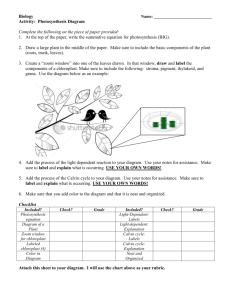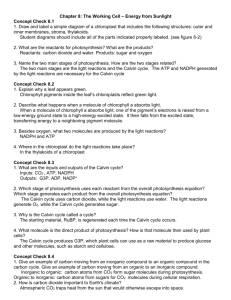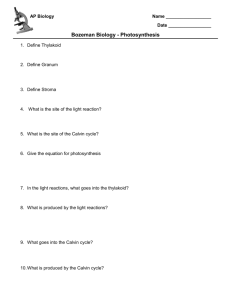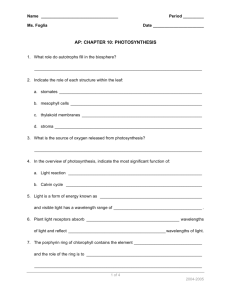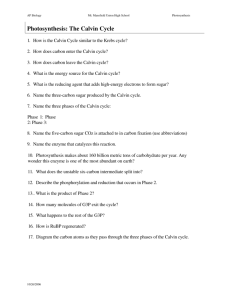Name_________________________ Class_____ Chapter 7
advertisement
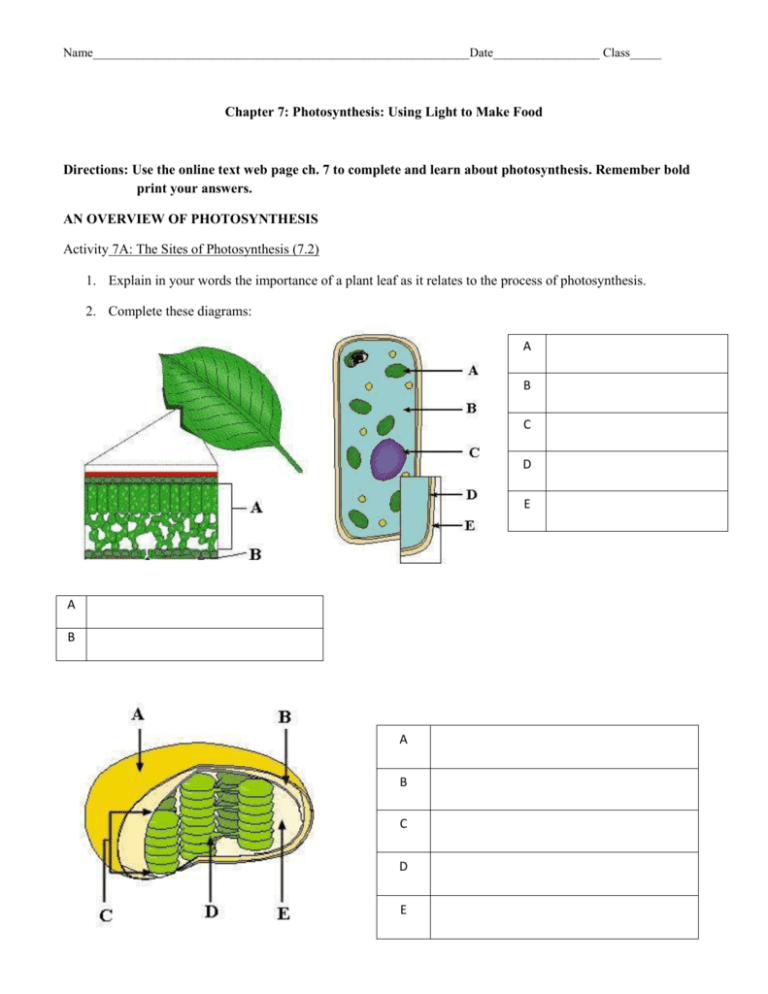
Name____________________________________________________________Date_________________ Class_____ Chapter 7: Photosynthesis: Using Light to Make Food Directions: Use the online text web page ch. 7 to complete and learn about photosynthesis. Remember bold print your answers. AN OVERVIEW OF PHOTOSYNTHESIS Activity 7A: The Sites of Photosynthesis (7.2) 1. Explain in your words the importance of a plant leaf as it relates to the process of photosynthesis. 2. Complete these diagrams: A B C D E A B A B C D E Activity 7B: Overview of Photosynthesis (7.5) 1. What is the formula for Photosynthesis? Explain in your words why this is an oxidation-reduction process 2. Using slide 2 Summarize in your words where photosynthesis is taking place (be specific). 3. Using slide 3 describe in your words how the light reaction and the Calvin cycle interact in the process of photosynthesis. Check your understanding of these concepts by completing the key concepts quiz. If you miss any of the questions go back through the activities and review the missed concepts and then retake the key concept quiz. THE LIGHT REACTIONS: CONVERTING SOLAR ENERGY TO CHEMICAL ENERGY Activity 7C: Light Energy and Pigments (7.6) 1. Sunlight is a type of energy called radiation __________________________. 2. The distance between the crests of two adjacent waves is called a _________________ . 3. The full range of electromagnetic wavelengths is known as the ___________________________ . 4. The ____________________ of __________________ use only certain wavelengths, or colors, of visible light. 5. Give the range of the visible light spectrum in nanometers. 6. At what wave length is green light roughly found? 7. Compare and contrast in your words both chlorophyll a and b. Activity 7D: The Light Reactions (7.9) 1. A. B. C. D. E. F. G. H. 2. Using these words summarize the first part of the light reaction explained on slide 2. (use your own words, think process here) photosystems, chlorophyll, electrons, hydrogen ions, stroma, thylakoid, photosynthesis 3. What is the importance of water in the process you just described? 4. Using slide 3 describe in your words the process that takes place in the second part of the light reaction. (notice that this is very similar to cellular respiration) 5. What are the final products of the light reaction and where will they be used next? Check your understanding of these concepts by completing the key concepts quiz. If you miss any of the questions go back through the activities and review the missed concepts and then retake the key concept quiz. THE CALVIN CYCLE: CONVERTING CO2 TO SUGARS Activity 7E: The Calvin Cycle (7.10) 1. What is the purpose of the Calvin cycle? Where is the Calvin cycle carried out? 2. Using slide one, explain why plants need carbon dioxide? 3. Using slide 2 which energy molecule from the light reaction is used first and how many? What are they used for? 4. Still using slide 2 which energy molecule from the light reaction is used second and how many? What are they used for? 5. What is the final product of the Calvin cycle? 6. How many G3P molecules continue in the Calvin Cycle? 7. So far the Calvin cycle has used the energy of the light reaction to reduce ____ carbon dioxide molecules and produce ____ molecule of G3P. 8. As the Calvin cycle continues how many ATP and NADPH molecules does the Calvin cycle use to produce one molecule of G3P? 9. What is the final product of the Calvin cycle? 10. How does the cell make glucose? Where did the energy in this glucose originally come from? Go back through each slide in this section and review the Calvin cycle then complete the key concept quiz in order to check your understanding of this concept. Bonus questions: Which of the 3 types of photosynthesis is most often found in desert plants? Explain how this process differs from the other two?
